
This museum was not made as a part of any official or supported project. Most of the displayed paintings are in our private property, the "Collection Horvath for Political Art". The aim of this exhibition is to provide useful and up-to-date information freely available in the net. Long-term aim is also to find a new home for the political pictures in a real "Museum of Political Art".
The idea underlying the "Collection Horvath" is described in the article "Die Sammlung Horvath für politische Kunst" by Patrick Horvath (in German).
Werner Horvath -
"Garden of Peace".
Oil on canvas, 60 x 80 cm, 2002.
Totalitarian Art
Dictatorship - oppression - persecution - tyranny - injustice
- inhumanity: All
these cruelties were present within the totalitarian regimes of the
20th century. Artists,
who worked under these circumstances were forced to adapt to the
state's ideology. Their
pictures can provide useful information for anyone, who is willing to
learn from the past
and wants to make up his mind for the dangers of dictatorship.
Destroying or suppressing
totalitarian art therefore would destroy and suppress free discussion.
(About the
background see also "Das
Gespräch - Über totalitäre
Kunst" in German).
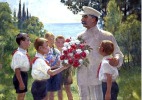 Socialist Realism
Socialist Realism
This style was an ideology enforced by the Soviet state as the official
standard for art.
It was defined 1934 at the First All-Union Congress of Soviet Writers
and was based on the
principle that art should promote political and social ideals set by
the state. The museum
shows paintings of socialist artists, for example (to name a few): Brodsky,
Bozhi, Ivanov, Karpov, Kupriynaov, Krylov, Shpolyanski, Parkhet,
Vasilev and
Vladimirski.
Nationalsocialist
Realism
Art style of the so called "Third Reich". Note: It is not the
intention of
the museum to glorify the Nationalsocialist regime ! On the
contrary, artworks of the
Nationalsocialist era are presented to initiate a broad discussion
about the relationship
between dictatorship and art of this time and to provide historical
information on-line.
Art
of the Austrian "Ständestaat"
The Austrian "Ständestaat" under Dollfuß was also a
kind of dictatorship. The
art of this time therefore also shows great political influence. Some
examples are shown.

 Werner
Horvath's New Constructivism
Werner
Horvath's New Constructivism
This section contains paintings of the Austrian artist Werner Horvath.
He calls his style "New
Constructivism" after the philosophical theory, based on the works of
Vico, Uexküll,
Glasersfeld, Watzlawick and others. The theoretical
background is explained in detail by the artist in a stage play in form
of a text-collage,
called "Jahrtausendwende -
Die Theorie des neuen bildenden
Konstruktivismus" (in German). Horvath tries to
show in his paintings, that
the so-called reality is not so "real" at all, for the world we live in
can be
understood as constructed by ourselves. For instance, colors do not
really exist, but are
products of the visual system and therefore are only "real" within our
consciousness. But also forms of all kind have no reality outside our
subjective world; on
the contrary they are built up by several psychological mechanisms. And
at last we have to
take into consideration, that we live in a "symbolic world": We see
Stalin not
only as a politician who lived from 1879 to 1953, but also as a symbol
of dictatorship and
cruelty.
As precursors of his style Horvath names Giuseppe Arcimboldo and
M.C.Escher. Most of
Horvath's paintings are influenced by political events or deal with
political problems.
 New
Constructivism - Politics
New
Constructivism - Politics
The paintings of this section show political events; the pictures tell
historical facts in
a critical way. You can see Che
Guevara, Fidel Castro, Mao, Karl Marx, Friedrich Engels, Lenin,
Stalin, Khrushchev, Brechnev, Gorbachev, Yeltsin, Putin, Ceausescu,
Milosevic, Karadzic, Walter
Ulbricht, Erich Honecker and others, also Adolf Hitler, even Osama bin Laden, Saddam Hussein, Ayatollah
Khomeini, Mahmoud Ahmadinejad, Kim Yong Il, George Bush, John F.
Kennedy, Bill
Clinton (and Monica Lewinsky), Arnold Schwarzenegger and Jaques Chirac.
New
Constructivism - Society
Marilyn Monroe, Madonna,
Jim Morrison, Michael Jackson and Kurt
Cobain are guests of this part of the museum. The paintings also
comment on problems like
drugs, Aids and pollution. A symbol for peace: John Lennon.
 New Constructivism -
Science, Medicine
New Constructivism -
Science, Medicine
Constructivistic portraits of scientists, often combined with realistic
scenes, explaining
the background of their work (e.g. Sigmund
Freud, Roentgen,
Billroth, Schweitzer, Koch and Albert Einstein).
As the section includes portraits of the infamous SS-doctor Josef
Mengele and of
the Nobel prize winner Wagner-Jauregg (who wanted to be a member of the
Nazi
party) - it is also a political
site.
New
Constructivism - Philosophy
Philosophy and politics are closely related, influencing each other.
You can see portraits
of Socrates, Nietzsche, Schopenhauer, Machiavelli, Sir Karl Popper,
Locke, Hobbes, Hume and Camus,
but also of Marx and Sigmund Freud.
Werner
Horvath - Greek Period
This section shows paintings from the so called "Greek period" of the
artist,
which followed his surrealistic phase. The period led to the
development of the "New
Constructivism". Hidden allusions to politics are included in the
paintings.
Werner Horvath - Early Works
This section shows art-works of Werner Horvath from the 60ies and 70ies
in the style of "Fantastic Realism", before his art-style turned to New
Constructivism.
 Recently finished:
"Linz -
European Cultural Capital 2009". Oil
on canvas, 2 x 2 m.
Recently finished:
"Linz -
European Cultural Capital 2009". Oil
on canvas, 2 x 2 m.
Text in Deutsch:
"Linz - Europäische
Kulturhauptstadt 2009".
Öl
auf Leinwand, 2 x 2 m.
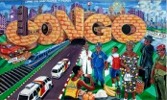

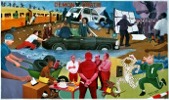
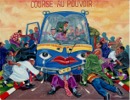 Congo
and Tanzania
Congo
and Tanzania
This section displays paintings from the Democratic
Republic of Congo
(formerly called Zaire) and Tanzania, dealing with problems of politics
and society in these countries.
See also:
Elections
2006 in the Congo - Reflections of African artists
March 2007 Violence in
Kinshasa - Reflections of African artists
The African dream of a
better life painted by Congolese artists
Hope is named Obama
- Reflections of artists of the Congo

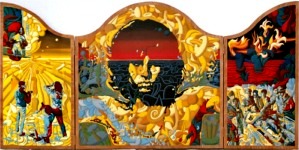
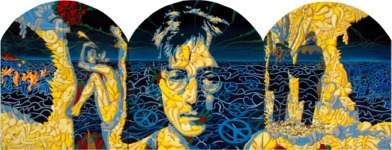
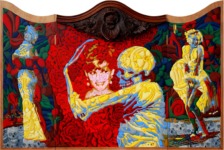
The
Kastellos-Altar (outer
left and left), The John-Lennon-Peace-Altar
(middle), and the Death
and the
Maiden - Triptych (right).
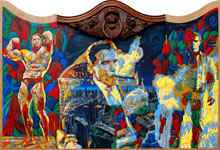
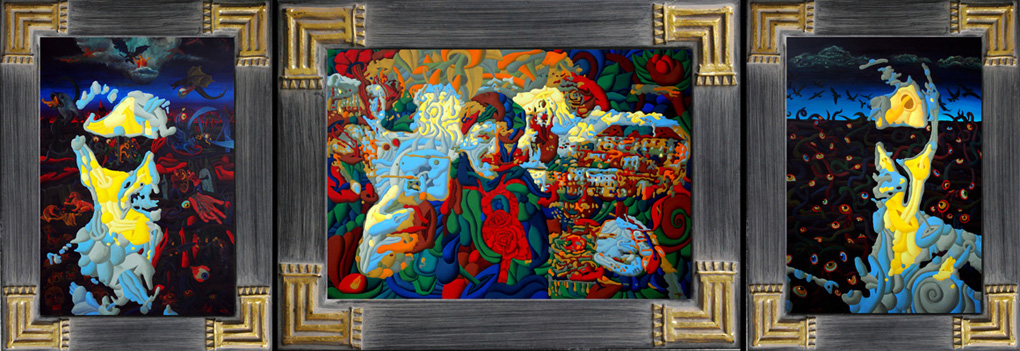 Recently
finished: Werner Horvath's
Recently
finished: Werner Horvath's
Arnold-Schwarzenegger-Altar
(left) and the
Self Portrait
Triptych
with Demons(right).
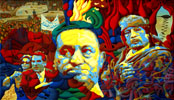 New:
Osama
bin Laden, Saddam Hussein and Muammar al-Qaddafi in art.
New:
Osama
bin Laden, Saddam Hussein and Muammar al-Qaddafi in art.
 Series
Series
Examples of this section are: Karel Stech (former Czechoslovakia) with
14 woodcut-prints
on "Imperialism" and Werner Horvath's giant "War and Peace",
consisting of 100 oil-paintings in the style of New Constructivism.
Updated
June 2022.
We are in the net since 1997.